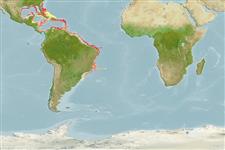Environment: milieu / climate zone / depth range / distribution range
Ecology
Marine; demersal; depth range 180 - 440 m. Deep-water; 32°N -
Western Atlantic: Georgia to Florida Keys in USA and Gulf of Mexico to southern Texas, USA.
Size / Weight / Age
Maturity: Lm ? range ? - ? cm
Max length : 33.0 cm TL male/unsexed; (Ref. 7251)
Adults mostly found on deeper part of shelf from 180 to 440 m. Young enter much shallower water.
Life cycle and mating behavior
Maturities | Reproduction | Spawnings | Egg(s) | Fecundities | Larvae
Robins, C.R. and G.C. Ray, 1986. A field guide to Atlantic coast fishes of North America. Houghton Mifflin Company, Boston, U.S.A. 354 p. (Ref. 7251)
IUCN Red List Status (Ref. 130435)
Threat to humans
Harmless
Human uses
Tools
Special reports
Download XML
Internet sources
Estimates based on models
Preferred temperature (Ref.
123201): 10.3 - 19.6, mean 15.4 °C (based on 59 cells).
Phylogenetic diversity index (Ref.
82804): PD
50 = 0.5156 [Uniqueness, from 0.5 = low to 2.0 = high].
Bayesian length-weight: a=0.00631 (0.00266 - 0.01494), b=3.11 (2.90 - 3.32), in cm total length, based on LWR estimates for this (Sub)family-body shape (Ref.
93245).
Trophic level (Ref.
69278): 4.2 ±0.8 se; based on size and trophs of closest relatives
Resilience (Ref.
120179): Medium, minimum population doubling time 1.4 - 4.4 years (Preliminary K or Fecundity.).
Fishing Vulnerability (Ref.
59153): Low vulnerability (23 of 100).
